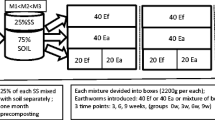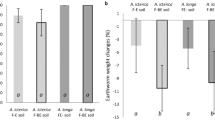Abstract
Metal-contaminated soil, from the El Arteal mining district (SE Spain), was remediated with organic (6 % compost) and inorganic amendments (8 % marble sludge) to reduce the mobility of metals and to modify its potential environmental impact. Different measures of metal bioavailability (chemical analysis; survival, growth, reproduction and bioaccumulation in the earthworm Eisenia andrei), were tested in order to evaluate the efficacy of organic and inorganic amendments as immobilizing agents in reducing metal (bio)availability in the contaminated soil. The inorganic amendment reduced water and CaCl2-extractable concentrations of Cd, Pb, and Zn, while the organic amendment increased these concentrations compared to the untreated soil. The inorganic treatment did not significantly reduce toxicity for the earthworm E. andrei after 28 days exposure. The organic amendment however, made the metal-contaminated soil more toxic to the earthworms, with all earthworms dying in undiluted soil and completely inhibiting reproduction at concentrations higher than 25 %. This may be due to increased available metal concentrations and higher electrical conductivity in the compost-amended soil. No effects of organic and inorganic treatments on metal bioaccumulation in the earthworms were found and metal concentrations in the earthworms increased with increasing total soil concentrations.




Similar content being viewed by others
References
Adriano DC, Wenzel WW, Vangronsveld J, Bolan NS (2004) Role of assisted natural remediation in environmental cleanup. Geoderma 122:121–142
Alloway BJ, Thornton I, Smart GA, Sherlock JC, Quinn MJ (1998) Metal availability. Sci Total Environ 75:41–69
Baes CF Jr, Mesmer RE (1976) The hydrolysis of cations. Wiley, New York, New York
Becquer T, Dai J, Quantin C, Lavelle P (2005) Sources of bioavailable trace metals for earthworms from a Zn-, Pb-, and Cd-contaminated soil. Soil Biol Biochem 37:1564–1568
BOE (2005) Real decreto 824/2005, de 8 de julio, sobre productos fertilizantes. Bol Oficial Estado 171:25592–25669
Crommentuijn T, Doodeman CJAM, Doornekamp A, Van Der Pol JJC, Van Gestel CAM, Bedaux JJM (1994) Lethal body concentrations and accumulation patterns determine time-dependent toxicity of cadmium in soil arthropods. Environ Toxicol Chem 13:1781–1789
Crommentuijn T, Doornekamp A, Van Gestel CAM (1997) Bioavailability and ecological effects of cadmium on Folsomia candida (Willem) in an artificial soil substrate as influenced by pH and organic matter. Appl Soil Ecol 5:261–271
Dai J, Becquer T, Rouiller JH, Reversat G, Bernhard-Reversat F, Nahmani J, Lavelle P (2004) Heavy metal accumulation by two earthworm species and its relationship to total and DTPA-extractable metals in soils. Soil Biol Biochem 36:91–98
Escoto M, Fernandez J, Martín F (2007) Determination of phytotoxicity of soluble elements in soils, based on a bioassay with lettuce (Lactuca sativa L.). Sci Total Environ 378:63–66
Fountain MT, Hopkin SP (2004) A comparative study of the effects of metal contamination on Collembola in the field and in the laboratory. Ecotoxicology 13:573–587
Friels W, Lombi E, Horak O, Wenzel WW (2003) Immobilisation of heavy metals in soils using inorganic amendments in a greenhouse study. J Plant Nutr Soil Sci 166:191–196
Garrido F, Illera V, García-González MT (2005) Effect of the addition of gypsum- and lime-rich industrial by-products on Cd, Cu and Pb availability and leachability in metal-spiked acid soils. Appl Geochem 20:397–408
González V, Diez-Ortiz M, Simón M, Van Gestel CAM (2011) Application of bioassays with Enchytraeus crypticus and Folsomia candida to evaluate the toxicity of a metal-contaminated soil, before and after remediation. J Soils Sediment 11:1199–1208
Grumiaux F, Demuynck S, Schikorski D, Lemière S, Leprêtre A (2010) Assessing the effects of FBC ash treatments of metal-contaminated soils using life history traits and metal bioaccumulation analysis of the earthworm Eisenia andrei. Chemosphere 79:156–161
Haanstra L, Doelman P, Oude Vashaar JH (1985) The use of sigmoidal dose response curves in soil ecotoxicological research. Plant Soil 84:293–297
Hobbelen PHF, Koolhaas JE, van Gestel CAM (2004) Risk assessment of heavy metal pollution for detritivores in floodplain soils in the Biesbosch, The Netherlands, taking bioavailability into account. Environ Pollut 129:409–419
Hooda PS, Alloway BJ (1994) Changes in operational fractions of trace metals in two soils during two years of reaction time following sewage sludge treatment. Int J Environ Anal Chem 57:289–311
Hsu JH, Lo S-L (2000) Effect of dissolved organic carbon on leaching of copper and zinc from swine manure compost. Water Sci Technol 42:247–252
ISO (1999) Soil quality—inhibition of reproduction of Collembola (Folsomia candida) by soil pollutants. ISO 11267. International Standardization Organization, Geneva
Kiekens L (1995) Zinc. In: Alloway BJ (ed) Heavy metals in soils, 2nd edn. Blackie, Glasgow, UK, pp 284–305
Lanno R, Wells J, Conder J, Bradham K, Basta N (2004) The bioavailability of chemicals in soil for earthworms. Ecotoxicol Environ Saf 57:39–47
Loureiro S, Ferreira ALG, Soares MVM, Nogueira AJA (2005) Evaluation of the toxicity of two soils from Jales Mine (Portugal) using aquatic bioassays. Chemosphere 61:168–177
Loveland PJ, Whalley WR (1991) Particle size analysis. In: Smith KA, Mullis CE (eds) Soil analysis: physical methods. Marcel Dekker, New York, pp 271–328
Marinussen MPJC, van der Zee SEATM, de Haan FM (1997) Cu accumulation in Lumbricus rubellus under laboratory conditions compared with accumulation under field conditions. Ecotoxicol Environ Saf 36:17–26
Melgar-Ramírez R, González V, Sánchez JA, García I (2012) Effects of application of organic and inorganic wastes for restoration of sulphur-mine soil. Water Air Soil Pollut 223:6123–6131
Mench M, Bussiere S, Vangronsveld J, Manceau A (2003) Progress in remediation and revegetation of the barren Jales gold mine spoil after in-situ treatments. Plant Soil 249:187–202
Mench M, Renella G, Gelsomino A, Landi L, Nannipieri P (2006) Biochemical parameters and bacterial species richness in soils contaminated by sludge-borne metals and remediated with inorganic soil amendments. Environ Pollut 144:24–31
Morgan AJ, Evans M, Winters C, Gane M, Davies MS (2002) Assaying the effects of chemical ameliorants with earthworms and plants exposed to a heavily polluted metalliferous soil. Eur J Soil Biol 38:323–327
Morillo J, Usero J, Garcia I (2004) Heavy metal distribution in marine sediments from the southwest coast of Spain. Chemosphere 58:431–442
OECD (2004) Guideline for the testing of chemicals no. 222, earthworm reproduction test (Eisenia fetida/Eisenia andrei). Organization for Economic Cooperation and Development, Paris
Owojori OJ, Reinecke AJ, Rozanov AB (2008) Effects of salinity on partitioning, uptake and toxicity of zinc in the earthworm Eisenia fetida. Soil Biol Biochem 40:2385–2393
Peijnenburg WJGM, Baerselman R, de Groot AC, Jager T, Posthuma L, van Veen RPM (1999) Relating environmental availability to bioavailability: soil-type-dependent metal accumulation in the oligochaete Eisenia andrei. Ecotoxicol Environ Saf 44:294–310
Rhoades JD (1982) Cation exchange capacity. In: Page AL (ed) Methods of soil analysis, Part 2. American Society of Agronomy, Madison, WI, pp 149–157
Saar RA, Weber JH (1980) Lead (II)-fulvic acid complexes. Conditional stability, and implications for lead (II) mobility. Environ Sci Technol 14:877–880
Scaps P, Grelle C, Descamps M (1997) Cadmium and lead accumulation in the earthworm Eisenia fetida (Savigny) and its impact on cholinesterase and metabolic pathway enzyme activity. Comp Biochem Physiol 116:233–238
Sierra M (2005) Niveles de metales pesados y elementos asociados en suelos de la provincia de Almería. Parámetros que los afectan y riesgo de contaminación. Ph.D. Thesis, Univ. Granada, Spain
Sierra M, Martínez FJ, Aguilar J (2007) Baselines for trace elements and evaluation of environmental risk in soil of Almería (SE Spain). Geoderma 139:209–219
Simón M, Dorronsoro C, Ortiz I, Martín F, Aguilar J (2002) Pollution of carbonate with in a Mediterranean climate due to a tailing spill. Eur J Soil Sci 53:321–330
Spurgeon DJ, Hopkin SP (1996) Effects of variations in the organic matter content and pH of soils on the availability and toxicity of zinc to the earthworm Eisenia fetida. Pedobiologia 40:80–96
Spurgeon DJ, Hopkin SP, Jones DT (1994) Effects of cadmium, copper, lead and zinc on growth, reproduction and survival of the earthworm Eisenia fetida (savigny): assessing the environmental impact of point-source metal contamination in terrestrial ecosystems. Environ Pollut 84:123–130
Stein JK (1983) Earthworm activity: a source of potential disturbance of archaeological sediments. Am Antiq 48:277–289
Stevenson FJ (1992) Humus chemistry. Genesis, composition and reactions. Wiley, New York, 1992
U.S. Salinity Laboratory Staff (1954) Diagnosis and improvement of saline and alkali soils. Handbook. US Department of Agriculture, Washington DC
Van Gestel CAM, Van Dis WA, Van Breemen EM, Sparenburg PM (1989) Development of a standardized reproduction toxicity test with the earthworm species Eisenia andrei using copper, pentachlorophenol and 2,4-dichloroaniline. Ecotoxicol Environ Saf 18:305–312
Van Gestel CAM, Dirven-Van Breemen EM, Baerselman R (1992) Influence of environmental conditions on the growth and reproduction of the earthworm Eisenia andrei in an artificial soil substrate. Pedobiologia 36:109–120
Van Gestel CAM, Dirven-van Breemen EM, Baerselman R (1993) Accumulation and elimination of cadmium, chromium and zinc and effects on growth and reproduction in Eisenia andrei (Oligochaeta, Annelida). Sci Total Environ 134(Suppl 1):585–597
Vangronsveld J, Ruttens A, Colpaert J, van der Lelie D (2000) In situ fixation and phytostabilization of metals in polluted soils. In: Luo YM et al (eds) Proc. Int. Conf. Soil Remediation Soil-Rem. Chinese Acad. Sci., Hangzhou, China, pp 262–267
Veltman K, Huijbregts MAJ, Vijver MG, Peijnenburg WJGM, Hobbelen PHF, Koolhaas JE, Van Gestel CAM, Van Vliet PCJ, Hendriks AJ (2007) Metal accumulation in the earthworm Lumbricus rubellus. Model predictions compared to field data. Environ Pollut 146:428–436
Williams DE (1948) A rapid manometric method for determination of carbonate in soils. Soil Sci Soc Am Proc 13:127–129
Zhang JL, Liu JG, Li C, Nie YF, Jin YY (2008) Comparison of the fixation of heavy metals in raw material, clinker and mortar using a BCR sequential extraction procedure and NEN7341 test. Cem Concr Res 38:675–680
Acknowledgments
This study was funded by the projects: CTM2009-07921 (Science and Innovation Ministry of Spain and FEDER), and P07-RNM-03303 (Andalusian Government and FEDER). The first author expresses her gratitude to the Innovation and Science Ministry of Spain, for a FPI fellowship and supported exchange visits in VU University Amsterdam. The Department of Ecological Science at VU University is thanked for the opportunity to work there and hospitality during my stay.
Author information
Authors and Affiliations
Corresponding author
Additional information
Responsible editor: Philippe Garrigues
Rights and permissions
About this article
Cite this article
González, V., Díez-Ortiz, M., Simón, M. et al. Assessing the impact of organic and inorganic amendments on the toxicity and bioavailability of a metal-contaminated soil to the earthworm Eisenia andrei . Environ Sci Pollut Res 20, 8162–8171 (2013). https://doi.org/10.1007/s11356-013-1773-z
Received:
Accepted:
Published:
Issue Date:
DOI: https://doi.org/10.1007/s11356-013-1773-z




